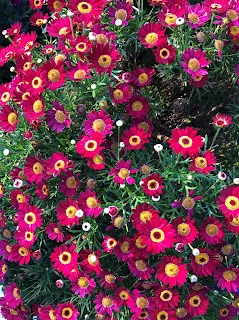Japanese follows English. 英語の後に日本語が続きます。
Since the outbreak of the coronavirus, I have been more observant and become able to see something which I couldn't before. One such example is that there are two types of azaleas, i.e., usual azalea (
tsutsuji) and Japanese azalea (
satsuki), growing in my neighborhood. I couldn't tell one from the other, so I made some research and learned the following:
- Japanese azalea's leaves/flowers are smaller than the usual one's.
- Japanese azalea flowers later (in May) than the usual one does (in April).
 |
1. Azalea (tsutsuji ツツジ)
Its flowers/leaves are larger than Japanese one's (below).
ツツジはサツキより花も葉も大きい! |
 |
2. Japanese azalea (satsuki サツキ) flowers later.
ツツジは4月、サツキは5月に咲く! |
These two azaleas made me want to see more pink flowers, so I dug into my photo archive and found these five pictures below (3 to 7).
Photo No. 3 below is ifafa lily. I googled the origin of the name, but only found that there is a place called Ifafa Beach in South Africa and no other information. In Japan it's called "flute blowing lily" or "kirutantsusu," i.e., the way of pronouncing its genus name "cyrtanthus" in Japanese katakana.
In the Japanese language of flowers, the ifafa lily represents shyness because of how they flower.
 |
| 3. Ifafa lily キルタンツス(笛吹水仙) |
The bright pink flower below (No. 4) is sea thrift I bought in anticipation of the current "stay-at-home" situation. It's now in the balcony of my room.
 |
| 4. Sea thrift ハマカンザシ |
This small flower (No. 5), which in Japan is compared to Japanese confetti, is pink knotweed. I took this photo a while ago, but haven't used it because I thought the flower was too plain, but the Covid-19 situation has got me to rethink about it. It may be small and plain, but lovely!!
 |
5. Pink knotweed ヒメツルソバ
|
The vivid pink of African daisy (No. 6) caught my attention, making me smile....
 |
| 6. African daisy セレニティ |
And last but not least is these small pink flowers whose name I couldn't find (No.7). They are so pretty!!
 |
| 7. Flower whose name I don't know |
A variety of pink flowers... They all soothed me...
(If you wish to post your comment but don't have a Google account, select "anonymous" from the drop down menu titled "comment as"!)
ツツジとサツキ(1と2)。名前は両方知っていましたが、違いについては知りませんでした。で、遅まきながら調べました。サツキは日本に自生していたもので花も葉も小さいんですね。見分けられるようになりました。
今回はピンクの花を集めてみました。花も色々、ピンクも色々です。
3はキルタンツス、和名は笛吹水仙です。花言葉は「恥ずかしがり屋」、「はにかみや」。
4はハマカンザシ、英名は「sea thrift」。なぜ「thrift(倹約)」なんだろうと思ったら「thrift」には「healthy and vigorous growth(植物の繁茂)」という意味もあるんですね。海岸(過酷な環境)でもよく咲くからみたいです。勉強になりました🙇!
5はこれまた可憐なヒメツルソバ、6は人目を惹くセレニティ、そして7は。。。。 分かりませんでした。
どのお花も個性的で癒されました☺!
(Google アカウントを持ってない方は、コメント記入後に「Google アカウント」をクリックし、「匿名」か「名前/URL」を選択してからご記入ください!)
























































